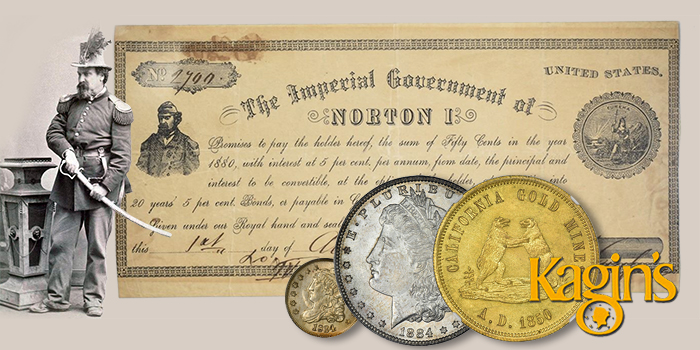
by Charles Morgan for CoinWeek…..
Kagin’s will conduct the third numismatic auction of their new series from September 21 to 24, 2018, in conjunction with the CoinExpo: the Santa Clara Coin, Stamp & Sports Collectibles Show.
The auction features three sessions and includes hundreds of items in a wide price range that is within the means of virtually every collector. Notable are a number of rare Mormon issues, a wide variety of paper money and scrip, including several unusual paper money errors, and a selection of U.S. coins and private issues.
The lot selection includes several potential sleepers and some fresh material as well.
After scanning the entire catalog and taking notes, I have put together my selection of four lots that you need to know!
Lot 2001: Emperor Norton I 50-Cent Interest-Bearing Note. PMG 30 Very Fine.
Tied for Finest and Featured in 100 Greatest American Currency Notes
A great piece of numismatic outsider art is this 50-cent bond issued by the Imperial Government of Norton I. The story of Emperor Norton is fascinating and more than one hundred and forty years later, still deeply felt by the city of San Francisco. A colorful figure in his later years, Norton was born in 1818 to Jewish parents, presumably in a town located on the outskirts of London.
In the early months of the California gold rush, Norton arrived in San Francisco with dreams of riches, but unlike most who arrived, he carried with him enough financial means and business acumen to parlay his savings into a small business empire in just three years time. Among his holdings were properties located on Sansome and Jackson Streets, two lots at Rincon Point, and a storage ship.
All of this went up in smoke after Norton bet wrong on a rice contract. Norton alleged wrongdoing and tried to back out of the deal, but ultimately lost when the Supreme Court of California ruled against him.
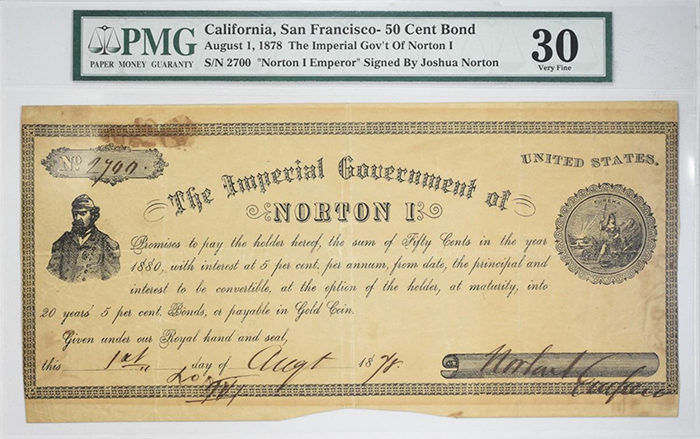
The bad deal and subsequent legal battle left him penniless and his properties were liquidated to pay off his debts.
In May of 1855, Joshua Norton the businessman was finished for good.
From here the story of Norton diverges down two lanes, one of fact and another of myth.
For the next four years, Norton earned a modest living brokering deals while he lived amongst the city’s working population. Despite the effort, he was in no position to restart his budding business empire and in 1859 he sent a notice to the San Francisco Evening Bulletin, where he proclaimed himself the Emperor of the United States.
And so he became Norton the first.
Norton lived his character and dressed in clothes provided to him by army officers stationed at the Presidio. He fancied himself royal blood and believed himself to be descended from the Bourbon dynasty.
Further public proclamations followed his first, and in due time Norton argued on the behalf of the city’s African American, Native American, and Chinese immigrant populations, lobbied for the construction of a bridge to connect San Francisco with Oakland, and supported women’s suffrage.
He also produced a series of interest-bearing bonds, which one must assume were backed more by fanciful self-delusion than anything more tangible. While thousands were issued throughout the Emperor’s reign, only a few dozen survive. Most are in poor condition.
In Kagin’s auction is a note that is recognized as the sixth type. It was printed by Chas. Murdoch & Company, presumably, free of charge.
The note that promises to pay “the holder hereof, the sum of Fifty Cents in the year 1880, with interest at 5 per cent (sic) per annum, from date, the principal interest to be convertible, at the option of the holder, at maturity, into 20 years’ 5 per cent. Bonds, or payable in Gold Coin.”
The recipient of this particular bond, which was issued out of order and hand-signed by Norton himself, may have been disappointed to find out that the emperor and empire would cease to be when Norton collapsed and died in the street on the evening of January 8th of the year of redemption. But given the Emperor’s outlandish personality, perhaps, the holder held onto it as a souvenir of one of the city’s most colorful characters.
PMG grades the note 30 Very Fine. It is one of just a few dozen Emperor Norton notes known and unlike most, does not appear to show signs of paper disintegration underneath the handwriting due to the acidic ink used in Norton’s pen.
Bidding starts at $7,000.
Lot 1026: 1834 Half Dime PCGS MS62. LM-2.
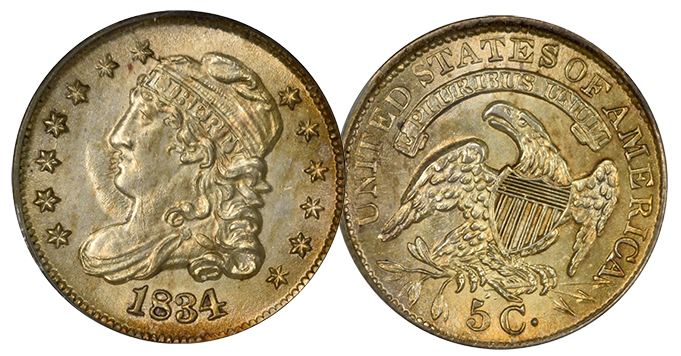
There are no great rarities in the short-lived Capped Bust half dime series and this is not a bad thing.
The short set, based on a William Kneass’ adaptation of John Reich’s design, was adopted for America’s tiniest silver denomination in 1829 and was put to use for the next nine years, as the Mint churned out the diminutive five-cent coin by the millions. Only in the years 1832 and 1837 did the mint’s coiners fail to strike one million pieces, falling short just barely.
For a classic U.S. coin series of the period, the Capped Bust half dime offers an attractive and affordable entry-level price point. Most of the known varieties are collectible and in Mint State the series can be collected for a few thousand dollars.
The present example was struck in 1834 and exhibits a pleasing golden patina and was very strictly graded MS62 by PCGS. It is encapsulated in Generation 4.1 holder, which means that it was graded between 2002-2004.
This grading opinion is remarkable when one considers the quality of this piece. Compared to other examples that I have seen in hand and those illustrated on PCGS Coinfacts, I see no reason why this example could not grade today one or two points higher.
Those who enjoy die state progression will note the presence of a long die crack that runs from Miss Liberty’s cheek down to her bust. The die roughness present to the left of Liberty’s mouth and chin is characteristic of the LM-2 variety.
Bidding Starts at $150.
Lot 1100: 1884-S Morgan Dollar. PCGS MS62.
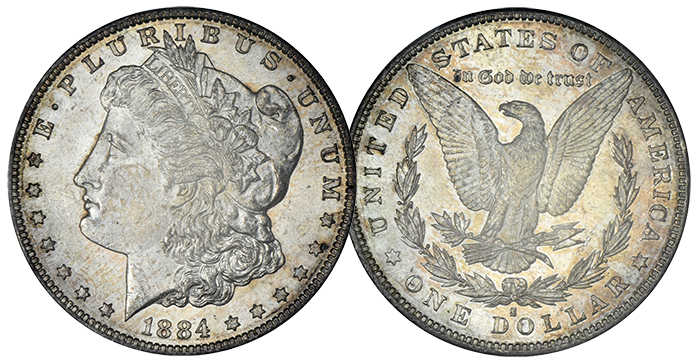
Overburdened by surplus bags of dollar coins that nobody wanted, the United States Mint was given the annual task of juggling production of the millions of coins that Congress had mandated under the Bland-Allison Act. Of course, the act was more a sop to western mining interests than a policy enacted for the public good. Such as it was, some quantity of the San Francisco’s 1884 output found its way into circulation, while the rest of it sat dormant until the federal government found a buyer for much of its surplus silver coin stockpile.
As a result, most of the mintage of the 1884-S dollar was melted down and converted into Indian Rupees.
Given that the size of the coin collecting hobby in America was small at the time and most collectors of the period were content collecting Proof issues from each date (mintmark collecting did not see widespread popularity until the second decade of the 20th century), the true scarcity of the 1884-S issue in Mint State lay hidden for decades.
Few 1884-S Morgan dollars were accounted for in the great bag run of the 1960s and based on estimates of several prominent silver dollar dealers, it is widely assumed that fewer than 2,000 examples of this issue survive in Mint State. Of that number, nearly all are low quality.
A notable exception to this rule is the Jack Lee coin, which was acquired in 1992 by collector Ralph Stone. That example, graded MS67 by PCGS and CAC-approved, brought $735,000 at a May 2018 Sotheby’s Auction. PCGS Coinfacts reports of one coin that is even better and assesses its value at $900,000.
The present example offered by Kagin’s is clearly not in that echelon of condition rarity. It is not a superb gem or the highest caliber but is a coin that is definitely choice uncirculated and perhaps even undergraded at PCGS MS62. Admittedly the reverse looks much better than the obverse, as is usually the case. But overall, the coin has a great original look and appears “fresh”.
PCGS reports 133 grading instances in MS62 with five at MS62+ and 55 at MS63. The market price of an MS62 at $20,500 and the price of an MS63 at $45,000. Expect the final hammer to fall somewhere in between these two numbers. We expect the buyer will be happy regardless.
Bidding Starts at $8,500.
Lot 1331: 1850 California Gold Mines Token MS64.
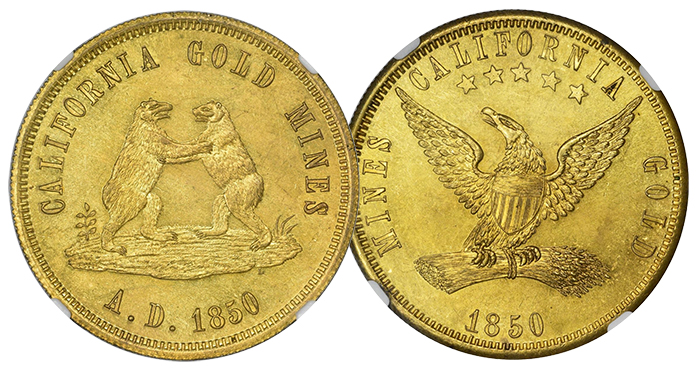
Numismatics is often a forensic science, where scholars and researchers pull from available evidence in order to see what is beyond the surface features of an object. This research can take quite a bit of time and sometimes, as is the case anytime primary source information turns up after much delay and up-ends the longheld beliefs about a coin. In the interim, we deal with presumption, assumptions, and a search for the most logical and reasonable explanations so that we might come to terms with what we think an object is.
As collectors, the tension of what we know and what we think we know manifests itself each and every day. It is naturally preferable to favor the side of order over the side of chaos.
Enter a piece like this. Struck to the size of a $20 gold piece and featuring a reeded edge with coin-turn die alignment, this gilt-copper private issue the purports to have been struck in 1850.
Most auction catalogs offer paper thin descriptions of it. Most point to Don Kagin’s short write-up in his landmark reference, Private Gold Coins and Patterns of the United States (1981). Kagin’s own research seems to point to the work of numismatist A.G. Heaton, who, in a 1912 monograph, published in the American Journal of Numismatics, credited the piece to San Francisco engraver William Lemme.
Heaton cites 19th-century collector A. Reimers, a San Francisco native, for the opinion that the piece was struck to be used as a counter in one of the city’ gambling halls. This was an opinion that ran contrary to another popularly-held opinion at the time, that the design was a pattern meant to be used to strike a private coinage. Evidence of this theory has never materialized.
Heaton and Reimers were not the only numismatists to have familiarity with the piece in 1912. Although the California Gold Mines token was then accurately described as rare, Farran Zerbe was said to have come by an example from an old lady in Cumberland, Maryland, who herself received it from her brother, a “forty-niner”.
Collector Joseph N.T. Levick, an important figure in 19thcentury numismatic circles (and first editor of the American Journal of Numismatics) also had a specimen. His piece was described as a gilt-Proof in Thomas Elder’s 1884 sales catalog of the Levick Collection. The piece brought $3.60.
Whatever the true origin story of the piece is, it is almost certain to have been struck at the period. Its popularity among collectors of California territorial pieces is self-evident.
The token’s effigy features two rampant bears embracing, or dancing with each other, coupled with the inscription: CALIFORNIA GOLD MINES, A.D. 1850, while the reverse features a heraldic eagle motif that bears a passing likeness for the one used on the reverse on various denominations of federal coinage.
NGC grades this example MS64. The same type in the NGC grade of MS62 brought $3,760 at a February 2017 Heritage Auction.
Bidding starts at $3,000.
* * *
Kagin’s September 2018 West Coast Auction
Session Listing:
Session 1: U.S. Coins, Exonumia, and Mormon Coins (Lot 1 – 164)
Friday, September 21, 2018 • 6 AM PST • View Session
Session 2: Session 2: Currency (Lots 2001-2111)
Friday, September 21, 2018 • 8 PM PST • View Session
Session 3: Online Session (Lots 3001-3125)
Monday, September 24, 2018 • 6 PM PST • View Session





Nice article. Very well written and informative. Thank you